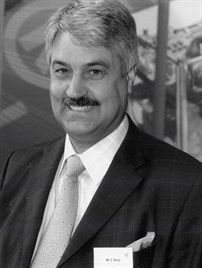 Peer review: Cliff Perry
Peer review: Cliff Perry
Former chairman of IMechE
The global strength of railways lies in their sustainability and high capacity potential. Road solutions based on the internal combustion engine now seem very 20th century. Electrified railways running on clean electricity deliver sustainable transport on current technology.
The vision of the Digital Railway therefore deserves universal approval. Who would vote against perfection? We are desperate to move our Victorian railway into something fit for the next 100 years and vision at the top of Network Rail is a vital component of success. The direction of the vision also aligns positively with the current Railway Technical Strategy. Another plus.
Someone has to lead the efficient adoption of relevant system technologies. If NR translates the promotion of this vision into leading genuinely collaborative development, that also scores highly. So good marks for Vision, Leadership, Alignment and Co-operation - all nine out of ten.
Reasonable challenges which follow are: Is it the right vision? Is the technology available? Are the timescales achieveable? Will the industry buy it?
- Right Vision? Partly. ETCS will become the cheapest way to resignal a railway. However, heavy rail has to move at Metro frequencies to meet demand, so the busiest lines need Automatic Train Operation as well. This is more than ETCS level 3, as currently defined. At the other end of the UK railway spectrum, on some lines operated by one train any signals at all represent unnecessary costs.
There are many capacity killers on our network, such as short trains, flat junctions and differential train performance. A single signalling solution will rarely provide the best business case for improvement.
- Is the technology there? Not yet. The current technology gap in UK rail is between what is possible and what we actually do. This vision needs new technology. Currently we are fitting brand new IEPs with redundant signalling equipment because we cannot deliver level 2 on the Great Western Main Line. Crossrail trains will operate on three different systems with undesirable transitions on every trip.
The devil is also in the detail - safe assumptions about guaranteed braking rates will always give enough gap between high-speed trains to hear the birds sing - and may well lower the capacity of Fenchurch Street.
- Are the timescales achievable? Highly doubtful, ETCS is a European project and the thought that we can unilaterally accelerate its development is over ambitious. The long-term costs of ending up with a UK-specific version are not worth one Control Period’s delay in implementation. Let’s get it right, not get it quick.
- Will the industry buy it? Not yet. NR has to commit to deliver on time to allow others to invest in the vision.
History of ETCS delivery is the problem here. Fitting the trains destroyed the reliability of the Cambrian Coast fleet, and operators may well be suspicious of NR pushing its signalling and control costs onto them.
System-wide collaboration is essential if we are to avoid producer-led ticketing solutions that do not suit the customers (or their representatives on railway Earth, the train operating companies). Real-time service adjustment and timetabling is overdue, although the best railway for producers and customers alike is one where everything happens to plan A.
Finally the skills gap: new railways, new trains, accelerated spend and major projects all need high-quality engineers to manage the changes safely and cost efficiently. Do they exist and are we getting the best into the industry in sufficient quality to meet the challenge?
- Summary: Vision 9/10, Reality check 4/10.











